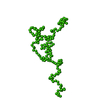+Search query
-Structure paper
| Title | Internal nanosecond dynamics in the intrinsically disordered myelin basic protein. |
|---|---|
| Journal, issue, pages | J Am Chem Soc, Vol. 136, Issue 19, Page 6987-6994, Year 2014 |
| Publish date | May 14, 2014 |
 Authors Authors | Andreas M Stadler / Laura Stingaciu / Aurel Radulescu / Olaf Holderer / Michael Monkenbusch / Ralf Biehl / Dieter Richter /  |
| PubMed Abstract | Intrinsically disordered proteins lack a well-defined folded structure and contain a high degree of structural freedom and conformational flexibility, which is expected to enhance binding to their ...Intrinsically disordered proteins lack a well-defined folded structure and contain a high degree of structural freedom and conformational flexibility, which is expected to enhance binding to their physiological targets. In solution and in the lipid-free state, myelin basic protein belongs to that class of proteins. Using small-angle scattering, the protein was found to be structurally disordered similar to Gaussian chains. The combination of structural and hydrodynamic information revealed an intermediary compactness of the protein between globular proteins and random coil polymers. Modeling by a coarse-grained structural ensemble gave indications for a compact core with flexible ends. Neutron spin-echo spectroscopy measurements revealed a large contribution of internal dynamics to the overall diffusion. The experimental results showed a high flexibility of the structural ensemble. Displacement patterns along the first two normal modes demonstrated that collective stretching and bending motions dominate the internal modes. The observed dynamics represent nanosecond conformational fluctuations within the reconstructed coarse-grained structural ensemble, allowing the exploration of a large configurational space. In an alternative approach, we investigated if models from polymer theory, recently used for the interpretation of fluorescence spectroscopy experiments on disordered proteins, are suitable for the interpretation of the observed motions. Within the framework of the Zimm model with internal friction (ZIF), a large offset of 81.6 ns is needed as an addition to all relaxation times due to intrachain friction sources. The ZIF model, however, shows small but systematic deviations from the measured data. The large value of the internal friction leads to the breakdown of the Zimm model. |
 External links External links |  J Am Chem Soc / J Am Chem Soc /  PubMed:24758710 PubMed:24758710 |
| Methods | SAS (X-ray synchrotron) |
| Structure data |  SASDDF6: |
| Source |
|
 Movie
Movie Controller
Controller Structure viewers
Structure viewers About Yorodumi Papers
About Yorodumi Papers




